I am trying to build a circuit that will make a LED to blink at a certain frequency, probably by using 555 timer. As the circuit will be supplied by a 3 Volt battery, so I want to extend a feature that LED should start blinking at a higher frequency indicating low battery status but I dont know how to add this feature to the circuit without adding any other IC or comparator.
Any help is greatly appreciated.
